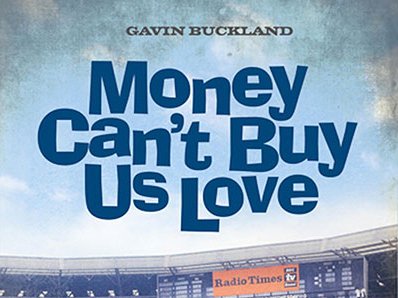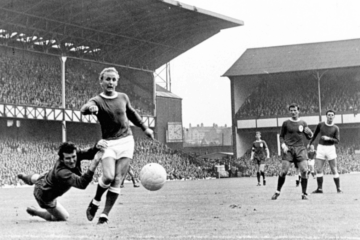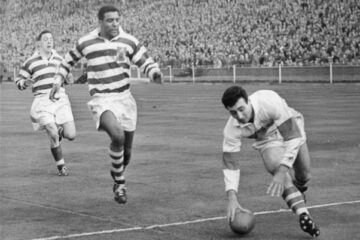
Two strong-willed, complicated, men form the axis of a new book by Gavin Buckland which explores, in greater detail than ever before, Everton during the trophy-laden 1960s Rob Sawyer
For those who have only been following Everton since the 1990s, you’ll have known the Blues as the plucky underdogs – the Dogs of War, even. It’s been the People’s Club, punching above its weight against opponents with much greater financial clout. For these younger supporters – even in this more financially stable and ambitious Moshiri-led era – it must be hard to envisage a time when the Toffees were the much envied moneybags of British football. Yet, throughout the 1960s, thanks to the ambition of one man, Everton was treated with much of the same suspicion – and grudging admiration – as Chelsea FC was early in the Roman Abramovich era. That man responsible was John Moores, the self-made multi-millionaire from Eccles who made his fortune in the Pools and Mail Order businesses.
Although long-associated with both Mersey football giants, the Littlewoods entrepreneur threw in his lot with Everton when he joined the board in 1960, quickly rising to Chairman. He gave the club the financial muscle, ambition and ruthlessness to win honours after a fallow period. In came Harry Catterick as manager, given a clear mandate to bring back the glory to Goodison. By and large, that is exactly what Catterick delivered, under the greatest of pressure from a man who not only expected but demanded success in short order. These two strong-willed, complicated, men form the axis of a new book by Gavin Buckland which explores in greater detail than ever before, this trophy-laden and fascinating period.
Buckland’s unstinting research has culminated in Money Can’t Buy Us Love: Everton in the 1960s – the title and cover artwork are wry nods the club’s unwanted Mersey Millionaires tag, referencing a certain mop-topped beat combo that hailed from the same city. At over 350 pages long, it is forensic in the level of detail and insights into how the club functioned both on and off the pitch. Yet it is also easily digested – either by reading the cover to cover (very tempting) or through more piecemeal perusal of the subject matter covered in the 26 chapters.
After some biographical information on Moores life and journey the Goodison throne, the book plunges into his dismissal of Carey in April of 1961 and appointment of Catterick just days later – it does reveal that another leading manager had been sounded out for the post some months earlier. Buckland highlights the expectations on the incoming man, who had been an Everton striker before forging a managerial career in the lower leagues and at Sheffield Wednesday. Although not ignoring the Darlington-born man’s shortcomings, it rightly hails his managerial acumen.
Catterick had, perhaps, the most high-pressure job in British football – and Buckland notes that he, by necessity, moved towards being more of a General Manager (or Director of Football, in modern terminology) than conventional tracksuit manager. Buckland gives Catterick due credit for blending Carey’s entertaining but mercurial players, such as Vernon, Young and Bingham, with his own astute signings to create the robust yet attractive unit which won the title in 1963. The author covers the subsequent tactical evolution from the tried-and-tested ‘WM’ 2-3-5 formation, through to experimentation with 4-2-4 in the mid-1960s and the adoption of the fluid 4-3-3 set-up – with a core of locally nurtured talent – which secured the League crown in fine style at the end of the decade. As well as the triumphs, the book does not shy away from less savoury subject-matter.
The life-ban for Tony Kay, lurid newspaper allegations in 1964, unexpected defeat in the 1968 FA Cup Final, a Greek tragedy in the 1970/71 European Cup, Catterick’s health problems and Alan Ball’s controversial departure for Arsenal all feature. Aside from the two main protagonists, many of the 1960’s significant figures at Goodison are profiled (Vernon, Labone, Kay, Young, Ball, Harvey, Kendall etc) whilst there are honourable mentions for rivals including Bill Shankly, Don Revie and Matt Busby. Tasty new nuggets of information served up for reader and Buckland also gives his own interpretation of events – often persuasively challenging long-accepted wisdom (an example being a fresh take on the oft-strained relationship between Alex Young and Catterick).
The author Buckland also gives context to Everton’s lack of ‘brand awareness’ beyond its hinterland, in comparison to the other big clubs of the era. Money Can’t Buy Us Love will become a go-to reference tome for scholars of the School of Science for years to come. I heartily recommend it both to those wishing to relive a golden Goodison decade and those seeking a clearer understanding of a defining era for the club and an appreciation of why – and how – five decades later, its impacts are still felt in L4. Money Can’t Buy Us Love: Everton in the 1960s is published by deCoubterin books and is on sale now through the deCoubterin website (https://www.decoubertin.co.uk/Evertonin1960s/), Amazon and all good bookshops.




